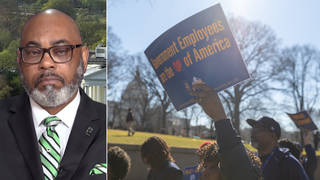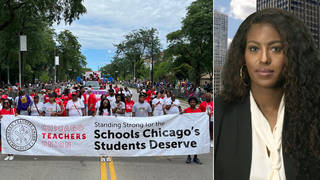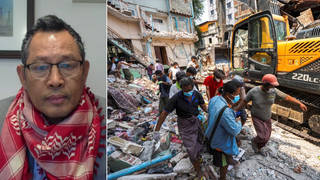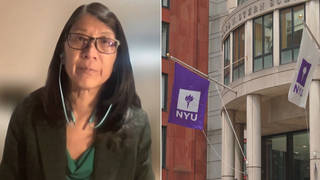
Guests
- Ahilan KadirgamarSri Lankan Tamil democracy activist and spokesperson of the Sri Lanka Democracy Forum. His latest article titled 'After The Tigers' appears in Himal Southasian magazine.
The Sri Lankan government offensive against the separatist Tamil Tiger rebels is continuing amidst growing concern for the fate of over 250,000 civilians trapped in the fighting. The Sri Lankan president declared Monday that the army was on the verge of crushing the rebels after a twenty-five-year war. The army’s attack has reduced the territory under rebel control from 7,000 square miles a year ago to just over 100 square miles today. [includes rush transcript]
Transcript
AMY GOODMAN:
We end up now on the issue of Sri Lanka, where the government offensive against the separatist Tamil Tiger rebels is continuing amidst growing concern for the fate of over a quarter of a million civilians trapped in the fighting.
The Sri Lankan government has said it cannot guarantee the safety of civilians “still living among LTTE terrorists,” referring to the rebel group known as the Liberation Tigers of Tamil Eelam, or LTTE. The government has asked civilians to leave the area, but it’s unclear where they can go, with aid workers reporting shelling even in the declared safe zone. The government has accused the Tigers of holding civilians against their will and using them as human shields, but the rebels deny this claim.
The Sri Lankan president declared Monday the army is on the verge of crushing the rebels after a twenty-five-year war. The army’s attack has reduced the territory under rebel control from 7,000 square miles a year ago to just a hundred square miles today.
The Red Cross reports hundreds of civilians, including children, have been killed or wounded in the fighting. On Sunday, at least thirteen people died after three artillery shell attacks hit an overcrowded hospital ward of mostly women and children. Local medical officials said the shells appeared to have been fired by the Sri Lankan military. But a government spokesperson told the BBC, “We totally reject that there was shelling. There was no shelling at all.”
Meanwhile, the Sri Lankan government is threatening to expel foreign diplomats, aid agencies, journalists from the region. On Sunday, Sri Lanka’s defense secretary accused CNN, the BBC and Al Jazeera of being sympathetic to the Tamil Tigers. Independent journalists are not allowed inside the conflict zone.
Last week, Sri Lankan Foreign Minister Rohitha Bogollagama defended his country’s human rights record after meeting with European Union officials.
ROHITHA BOGOLLAGAMA: There are no human rights abuses in our country. This is something we are very conscious to try and fill up, and we have a zero tolerance approach in terms of human rights abuses in the country. There is a conscious pursuit of any violations committed by the government through the administration of the legal system.
AMY GOODMAN:
I’m joined right now in the firehouse studio by Ahilan Kadirgamar. He’s a Sri Lankan Tamil democracy activist spokesperson for the Sri Lanka Democracy Forum. His latest article is called “After the Tigers.” It appeared in the Himal Southasian magazine.
We welcome you to Democracy Now! Lay out the scope of the problem right now in Sri Lanka.
AHILAN KADIRGAMAR:
The immediate concern, Amy, is the humanitarian situation in the district of Mullaittivu. While the LTTE is on its last legs, there are about 250,000 people trapped in that area. And the government is going forward with the offensive. The LTTE is not allowing the civilians to leave. There is a designated safe zone; however, the shelling, in particular, is continuing to kill civilians. There’s also concerns that many of the civilians trapped in that territory are perhaps unwilling to come out of that territory also because of a lack of internationally mandated rehabilitation camps. The rehabilitation camps are currently controlled by the security forces, and there’s a lot of fear for the civilians to also come out of the territory.
But the LTTE is also holding the civilians more or less hostage. And in the past, the LTTE has had no concerns about provoking violence on the civilians who have tried to gain legitimacy. At the same time, the military also does not seem to care much about the civilians at all. This war is being fought with much Sinhala nationalist propaganda. So it’s a very serious situation, probably the worst we’ve seen in the last couple decades.
AMY GOODMAN:
Why is the Sri Lankan government cracking down now?
AHILAN KADIRGAMAR:
The war has been going on now for about three years. There was an internationally mandated Norwegian peace process from 2002 to 2005. The LTTE escalated the war on a miscalculation that they could gain territory. And now the war is more or less coming to an end, as I mentioned, with the LTTE more or less decimated. But what would happen in the next few weeks is of serious concern, particularly in terms of the situation of civilians.
AMY GOODMAN:
What about this clinic that we’ve been hearing about, see video images of, also the Sri Lankan government attacking the media, not allowing the media in, calling them Tamil sympathizers, like BBC, like CNN, like Al Jazeera?
AHILAN KADIRGAMAR:
The hospital in Puthukkudiyiruppu, the last sort of town under the hold of the Tigers, has had shells fall in it and kill a number of civilians. That’s the last functioning hospital. And it’s very important, as ICRC has also called on, to cease shelling of particularly those sort of areas where civilians are present.
Now, there has been a crackdown of the media in Sri Lanka now over the last two years with the onslaught of the war. While there have been statements like the one you read about the international media, Sri Lankan journalists — now, there was a very prominent journalist, Lasantha Wickremetunge, who was assassinated, and, by all accounts, it was done by state-linked actors.
AMY GOODMAN:
In fact, didn’t he write a letter to be read after his death that said, “If I am killed, it’s by the Sri Lankan government”?
AHILAN KADIRGAMAR:
That’s right, yeah. And that’s gotten a lot of publicity. So I think journalists like him — there have been a number of journalists who have either been killed or beaten up and/or threatened. So, many of them are aware that if they write about the war, if they write critically about the war effort, that they will be targeted. And this attack on the media is very worrying, because it also points to the overall health of the country, the democratic health of the country.
AMY GOODMAN:
What is the future of the Tamil Tigers? What is the future of the people of Sri Lanka?
AHILAN KADIRGAMAR:
The future of the Tamil Tigers might be over. The Tamil Tigers were never serious about a political solution. They, themselves, assassinated and murdered a number of the Tamil leaders, other aligned Tamil movements.
But the question of not only the Tamil community, but the minorities, remains in Sri Lanka. Tomorrow, Sri Lanka celebrates its sixty-first anniversary of independence, and over these last sixty-one years, there has been systematic discrimination against all the minorities in Sri Lanka. I mean, I say all the minorities. There is a sizable Muslim community. There is what we call the Upcountry Tamil community, indentured labor brought over by the British to work in the plantations, and then, of course, the Lankan Tamil community. And then there are minorities such as caste minorities, the rural poor in the south.
So all their concerns have to be addressed through a political process. It has to be a just political process. And that’s what we normally mean by a political solution. That would entail constitutional reform, addressing, for example, discrimination in education, in implementing language policy. All these concerns have to be addressed, if Sri Lanka is to have a healthy political culture.
AMY GOODMAN:
And for people who do not know Sri Lanka, if you can explain its history briefly, and the Sinhalese majority, the Tamil and others minority, and how they came to this point.
AHILAN KADIRGAMAR:
Sri Lanka, as I mentioned, gained independence in 1948. And, you know, in Sri Lanka, there are, as I mentioned, four ethnic — broadly, four ethnic communities. There’s the Sinhala majority, which makes up about 73 percent of the population. Then there is a Tamil minority, anywhere from 12 to 15 percent. Then a Muslim minority and an Upcountry Tamil community.
Now, the state has been controlled by the Sinhala majority. So we say in Sri Lanka that there is a problem of a majoritarian democracy that is unwilling to accommodate the minorities. Twenty-five years ago, about thirty years ago, a number of Tamil movements took up arms to challenge the state. And eventually, the LTTE decimated all the other Tamil movements in order to claim that they are the only representatives of the Tamil community, and that was the beginning of this escalation of the war.
AMY GOODMAN:
We only have thirty seconds, but is there a role that the US plays and that you think people in this country can be involved in being a part of the solution?
AHILAN KADIRGAMAR:
The US, the international community and, more importantly, India have an important role to ensure that there is a political solution in Sri Lanka. And any concern that could be addressed , the immediate concerns about the humanitarian situation, the attacks on the media and then the longer-term concern of a political solution, would be much needed in the form of solidarity.
AMY GOODMAN:
I want to thank you for being with us. Ahilan Kadirgamar is a Sri Lankan Tamil democracy activist, spokesperson for the Sri Lanka Democracy Forum. And we’ll link to your website and writings at democracynow.org.












Media Options